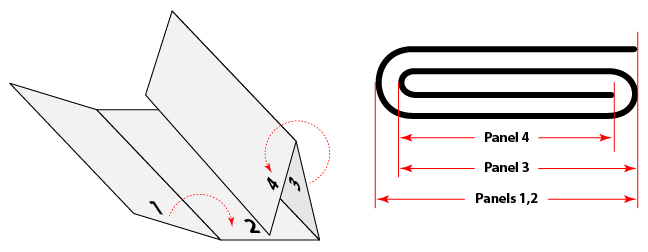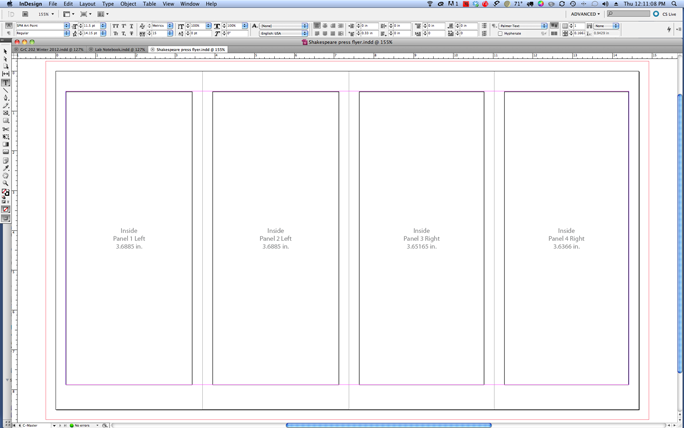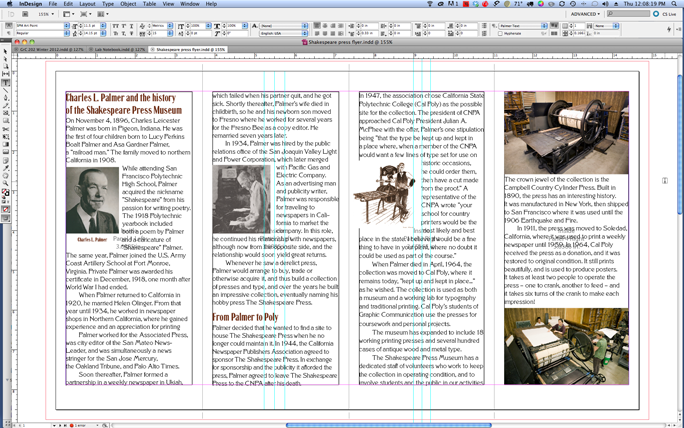This is an update of a blog I wrote in 2010. I added new information based on a new version of the flyer discussed.
I printed a project in late summer – a four-panel “tourist” flyer designed to go into one of those racks at the Chamber of Commerce, on hotel Concierge desks, and at the airport. It is designed to compete with flyers for hot-air balloon rides over Napa, Disneyland, and Universal Studios. By comparison, the Shakespeare Press Museum is an exciting activity!
The final dimensions are 3.6667 x 8.5, a standard width for such flyers.
The problem with these types of projects is the folding and the margins. I wanted this one to be perfect: folded right where I want it to fold, artwork and text perfectly centered in each column. I am sure that you have seen many flyers that fail to fit when folded; that’s easy: divide a sheet into thirds and design a flyer on each panel, then fold it. Oops!
Fold-overs, sometimes called rolling folds (shown above) cause trouble because the panel being folded-in must be shorter than the others. Over the years I have adopted a formula for making these folds precisely, and here it is:
Let’s take a three-fold flyer as our first example: U.S. Letter size 8.5 x 11 in., final folded size approximately 3.667 x 8.5. I say “approximately” because the outside panels will be very slightly larger, a result of the compensation for the fold-in panel.
My formula is 5 times the paper thickness (caliper) subtracted from the fold-in panel, and then split and added to the other two panels. One could trim the finished sheets to a size just under 11 inches if necessary, but for this example I will assume that the 11-inch dimension will remain.
When I was a younger man, I practiced graphic arts on a drafting table with a T-square and right-triangle. Back then I would simply subtract 1/16 inch (0.0625 in.) from the fold-in panel, and fudge the rest. The problem with fudging is that the columns would never balance, and one or both the outside panels would be slightly off-center. So, I worked on the formula over time, and now I am pretty confident in it.
My flyer for the Shakespeare Press Museum is a four-fold, with two rolling folds. For that I needed to compensate twice – once for the right-most panel, and again for the second fold-in panel (including the right panel). For most of us this is pretty obvious. But what is not obvious is that anything you subtract from a panel must be added back to the static panels in even parts so that the “outside” panels fold exactly in half, and the rolling folds fold in without causing trouble.
For my four-panel flyer I am using paper that is 0.003 in. in caliper. The panels work out to be as follows (inside of the sheet, left-to-right):
Four-Panel Flyer dimensions: Sheet size (trim) 14.667 x 8.5 in.
Panel A: 3.667 + 0.022 = 3.689 in.
Panel B: 3.667 + 0.022 = 3.689 in.
Panel C: 3.667 – 0.015 = 3.652 in.
Panel D: 3.667 – 0.030 = 3.637 in.
When you add those up it comes to 14.667, the original paper dimension.
When making my layout in Adobe InDesign, I created two Master Pages, one with these dimensions, and one the mirror of these dimensions for the other side of the sheet. Then I put text boxes (essentially guidelines) inside each one with my chosen margins.
Ironically the text columns are all different (except the outer two), so all of the artwork in the flyer must be adjusted slightly to fit these slightly different column widths. My constant was the margins between the text and the fold on each panel; that’s where it counts, because the distance from the text to the fold must look consistent.
For the Shakespeare Press flyer I printed small tick-marks in the bleed area to mark my folds according to these dimensions. Folding exactly on those tick-marks creates a perfect flyer. The two panels fold-in nicely, the outer panels are precisely the same size, and outer dimension is (only) 0.022 greater than the desired 3.667 inch objective. No one at the Chamber of Commerce will notice.
But tourists and visitors will flock to the museum as a result of seeing our flyer!
___
I’m writing a new book about printing processes and prepress. Click on the link below to give me your e-mail address, and I will let you know when the book is published (target date is March, 2012).






Dear Brian,
Thank you very much for this helpful post! I was struggling with this and was able to figure out the math for a 6-panel roll fold based on your post. Thanks for the the introduction of using caliper. I did a search and there are average Paper Thickness (Caliper) Charts available which I wasn’t aware of before. One helpful tip that I got from Trish Witkowski was to convert everything to points rather than inches to minimize rounding errors.
Best,
Leah
Thank you for your comment. Though I agree that changing things to points is OK, they are very large (1 point = 0.0138 in.) compared to thousandths of an inch. If working with points, you’ll get a fractional point value, and you need to keep track of it. BUT… it’s not the end of the world if you are off by a few thousandths. Keep up the good work!
What do you think was added for variation in the folding machine process?